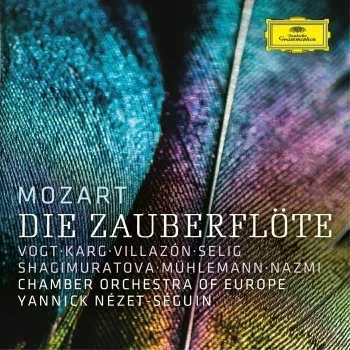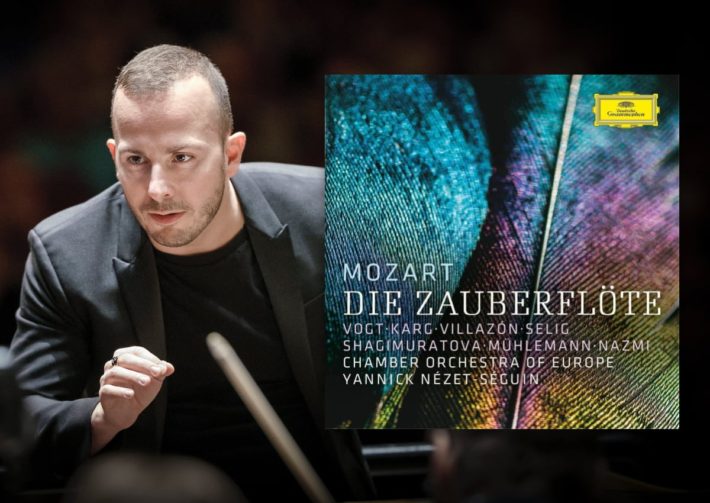In his latest, highly acclaimed series of Mozart operas, Yannick Nézet-Séguin turns his attention to Die Zauberflöte (“The Magic Flute”). This inspirited and refreshing recording features an outstanding cast of singers. As in the rest of this opera cycle, Nézet-Séguin conducts the Chamber of Orchestra of Europe.

Nézet-Séguin employs energetically effervescent and vigorous tempos, faithful to Mozart’s indications, creating a sense of excitement. While the instrumental accompaniments may initially seem vivacious, Nézet-Séguin’s understanding of Mozart’s melody and textures is empathetic to the music with an intrinsic sense of phrasing. Melodies are paced with direction, but seem unhurried over the various styles of accompaniment. The singers all have uniquely distinctive vocal qualities, allowing their characters to be easily identifiable, but also blend pleasingly in the ensemble numbers. Each singer is a character actor bringing a drama and spontaneity not only to the music but also to the spoken passages, included in full in this release.
Tenor Klaus Florian Vogt brings a dramatic quality to the role of Tamino, as illustrated in the aria “Dies Bildnis ist bezaubernd schön” (CD 1, track 6). Here and throughout, Vogt is authoritative and assured, with classically authentic phrasing (though not without effort in the more powerful segments or high notes). Aptly matching as Pamina, Soprano Christiane Karg employs a convincing youthful lyricism. In the aria “Ach, ich fühl’s, es ist verschwunden”, her prolonged melodic lines have an emotional intensity and a beautiful legato.
Following their collaboration in all previous releases in this series, tenor Rolando Villazón is a central cast member, this time in the role of Papageno, usually performed by a bass or a baritone. An unusual choice, but as most of Mozart’s writing is high for a bass, it is only the occasional notes at the lower end of his tessitura which lacks projection. In the duets passages of “Hm, hm, hm, hm” with Tamino and in “Bei Männern, welche Liebe fühlen” (CD 1, track 11) with Pamina, the blend of voices is refined. When joined by Regula Mühlemann as Papagena, Villazón changes the color of his voice to match that of Mühlemann, and together they present an endearing and bright rendition of “Pa-pa Papagena/Papageno”.
The Queen of The Night — coloratura soprano Albina Shagimuratova – is not as fearful as some exponents who sing this role, such as Erika Miklósa in Claudio Abbado’s recording. On both “Zum Leiden bin ich auserkoren” and “Der Hölle Rache kocht in meinem Herzen”, Shagimuratova ascends effortlessly to the stratospheric heights of the human voice. Her style of vibrato, however, is down to personal taste. Franz-Josef Selig has an expressive voice which brings a smooth and rich tone to the part of Sarastro. His uses a lovely, prayer-like legato in “O Isis und Osiris”, but is not as authoritative as Rene Papé, again for Abbado.
The RIAS Kammerchor are pristine in their diction and intonation, and are finely balanced – try the male chorus in the first act’s final segment. Equally as good are the innocent-sounding trebles (“The Three Spirits”), who impressively place the consonants with unity and precision. Like many members of the cast, “The Three Ladies” have highly distinctive voices, but blend extremely well with their ensembles from the outset.
The recording of the orchestra is close and captures the bass with particular clarity. Individual voices are balanced appropriately against the orchestra. The important flute, piccolo and glockenspiel playing is characterful and adds to the magical air. Recorded live in July 2017 at the Festspielhaus Baden-Baden, the reverberant acoustic adds theatricality, enhancing the overall experience.
As comparisons go, René Jacobs’ 2010 Die Zauberflöte has a greater sense of drama with a stronger Tamino and Pamina (Daniel Behle and Marlis Petersen, respectively). He also enjoys a more astutely balanced studio production and imaginative sound effects. Jacob’s Akademie für Alte Musik Berlin offers a period sound, whilst Nézet-Séguin’s COE offers a dexterity coming close to Jacob’s nimbler approach. For a live comparison, Claudio Abbado’s high profile cast with the Mahler Chamber Orchestra is a noteworthy version.
The booklet contains an interesting essay, synopsis and full libretto with English translation. Overall this is an enjoyable, well-presented and commendable release from Deutsche Grammophon, making it a worthy and complementary recording to Nézet-Séguin’s other Mozart operas performances.
Top image: ©️ Hans-Van-Der-Woerd
Mozart – Die Zauberflöte
Sarastro – Franz-Josefselig
Königindernacht Albina Shagimuratova
Pamina – Christiane karg
Tamino – Klaus florian vogt
Papageno – Rolando Villazón
Papagena – Regula Mühlemann
Chamber Orchestra of Europe
Yannick Nézet-Séguin – Conductor




















